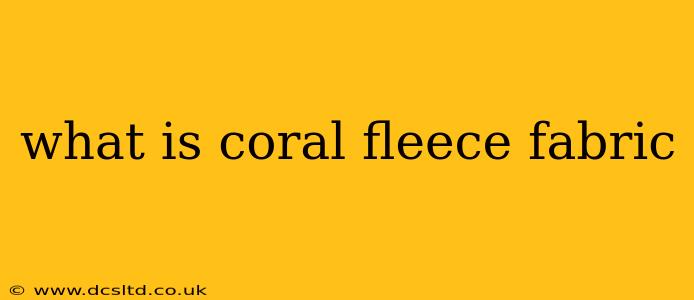Coral fleece fabric is a popular synthetic textile known for its incredibly soft, plush texture and exceptional warmth. Its name evokes the feeling of touching a coral reef, referencing its fuzzy, slightly bumpy surface. But what exactly makes this fabric so special, and how is it made? This comprehensive guide will delve into the properties, uses, and care of coral fleece fabric.
What are the properties of coral fleece fabric?
Coral fleece boasts a unique combination of desirable properties that contribute to its widespread popularity. These include:
-
Exceptional Softness: The hallmark of coral fleece is its unbelievably soft hand feel. This luxurious softness makes it ideal for garments and home textiles designed for comfort.
-
Excellent Warmth: The dense pile structure traps air effectively, providing excellent insulation and making it perfect for colder climates. This makes it a popular choice for blankets, robes, and pajamas.
-
Lightweight: Despite its warmth, coral fleece remains relatively lightweight, making it comfortable to wear and easy to handle. This is a significant advantage over heavier fabrics like wool or thick cotton.
-
Water Absorbent: While not as absorbent as towels made from 100% cotton, coral fleece possesses reasonable water absorbency, making it suitable for certain applications.
-
Easy to Maintain: Generally, coral fleece is easy to care for, requiring minimal effort for cleaning and maintenance. (More details on care are provided below).
-
Affordable: Compared to other plush fabrics, coral fleece is relatively inexpensive to produce, making it accessible to a wide range of consumers.
What is coral fleece fabric made of?
Coral fleece is typically made from 100% polyester. This synthetic fiber contributes to its softness, durability, and easy care properties. However, blends with other fibers are sometimes used to modify specific characteristics, such as adding a touch of cotton for enhanced absorbency.
How is coral fleece fabric made?
The manufacturing process involves several steps, including spinning polyester fibers into yarn, knitting or weaving the yarn into a fabric base, and then raising the fabric surface to create the characteristic plush pile. This piling process is crucial in giving the fabric its distinctive softness and texture.
What is coral fleece fabric used for?
The versatility of coral fleece makes it suitable for a vast range of applications, including:
-
Blankets and Throws: Its softness and warmth make it an excellent choice for cozy blankets and throws.
-
Robes and Pajamas: The comfortable and warm nature of the fabric makes it ideal for loungewear.
-
Clothing Linings: Coral fleece can be used as a lining for coats and jackets, providing an extra layer of warmth and comfort.
-
Toys: Its soft and cuddly texture makes it perfect for stuffed animals and other children's toys.
Is coral fleece fabric hypoallergenic?
While generally considered hypoallergenic, individual reactions can vary. Polyester, the primary component, is less likely to trigger allergic reactions than natural fibers like wool or cotton for some people. However, it's crucial to note that individuals with sensitivities to synthetic fabrics may still experience irritation.
How to care for coral fleece fabric?
Proper care ensures the longevity and softness of your coral fleece items. Generally, it’s recommended to:
- Machine wash in cold water: Avoid hot water, which can damage the fibers.
- Use a mild detergent: Harsh detergents can strip the fabric of its softness.
- Tumble dry on low heat or air dry: High heat can shrink or damage the fabric.
- Avoid bleach: Bleach can weaken the fibers and discolor the fabric.
What is the difference between coral fleece and other fabrics like microfiber?
While both coral fleece and microfiber are synthetic fabrics known for their softness, there are key differences. Microfiber tends to have a smoother, denser weave, resulting in a more refined feel. Coral fleece, on the other hand, has a more pronounced, textured pile that contributes to its unique softness and warmth. Microfiber is often used in towels and cleaning cloths due to its excellent absorbency, whereas coral fleece is prized more for its warmth and comfort in blankets and clothing.
In conclusion, coral fleece fabric is a versatile and popular textile appreciated for its softness, warmth, and affordability. Its wide range of applications and relatively simple care requirements make it a practical and comfortable choice for various uses.
